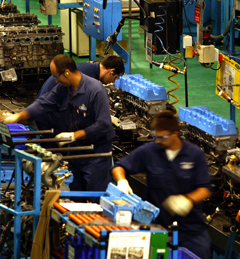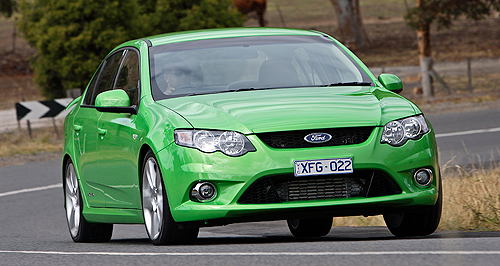Make / Model Search
News - Ford - FalconFord's Aussie six faces new challengeThreatened: Ford's venerable I6 has been produced in Geelong since 1960. New emission standards could knock out local Ford six-cylinder engine12 Jan 2010 By JAMES STANFORD in DETROIT FORD Australia says engineering its locally produced in-line six engine to meet upcoming Euro 5 emission standards will be “difficult”. The federal government last week released a draft report prepared by the transport department which recommends the Euro 5 emissions standard be introduced in Australia between 2012 and 2014. The deadline for the Ford Australia I6, should the report be approved and legislated, would be 2013. The Euro 5 emission deadline looms as a possible end-date for the 4.0-litre engine that has been produced in various forms in Geelong since 1960 and is used for all locally produced models including Falcon, Falcon Ute and Territory. Ford Australia announced in mid-2007 that it would end production of the Australian engine due partly to the fact that it would have cost too much to upgrade it to meet Euro 4 engine standards that come into force halfway through this year. That decision was later reversed due to a range of factors, including the view that the engine could be engineered to meet Euro 4 standards for far less investment than was first estimated. While engineers were able to upgrade the engine to the Euro 4 standard with very little change, adapting it to meet Euro 5 standards will be a far greater, and more expensive, task.  Ford Australia spokeswoman Sinead McAlary told GoAuto that engineers were already looking at ways the current engine could be upgraded to meet the Euro 5 regulations, but said it would not be easy. Ford Australia spokeswoman Sinead McAlary told GoAuto that engineers were already looking at ways the current engine could be upgraded to meet the Euro 5 regulations, but said it would not be easy.“There is no doubt it is going to be difficult, but we thought Euro 4 was going to be hard as well,” Ms McAlary said. She said the report came as no surprise to Ford Australia. “We had known that they were going to put out this report it had to come sooner or later,” she said. Ford Australia would weigh up several options before it made a decision on the future of the in-line six plant in Geelong and whether upgrading it to meet Euro 5 would be viable, Ms McAlary said. “What we have to do now, now that there is a deadline is, is ask whether it is possible. If it is possible, then, how much?” she said. “A business case and engineering study has to be done.” Ms McAlary said Ford Australia was keen to continue producing the in-line six which started off as Ford North America 2.4-litre unit into a modern dual-VCT 4.0-litre engine unique to the Australian operation. “We always work on the idea of never say never,” she said. With the current Falcon due for replacement in Falcon due in 2015, it is possible that the Euro 5 deadline could arrive quite close to the introduction of an all-new model that would either have an upgraded Australian I6 or US derived engine. In this case, Ms McAlary said that it would, hypothetically, consider requesting an exemption to continue producing the current engine for a short period until the new vehicle arrived. Ford Australia announced last July that it would introduce a turbocharged four-cylinder EcoBoost engine, which would meet Euro 5, for the Falcon in 2012. Asked if Ford Australia would consider dropping the I6 upon the introduction of the Euro 5 standard and selling Falcon with only a four-cylinder EcoBoost, Ms McAlary indicated this was unlikely. “I don’t think just running with EcoBoost would ever be our strategy,” she said. “EcoBoost will satisfy a group of customers who are primarily driven by fuel economy, but there will be customers who are after performance.” The transport department report recommends that Euro 5 standards be introduced for newly introduced petrol vehicles in 2013 and existing vehicles in 2014. Newly introduced diesels would need to meet the Euro 5 standard by 2012 and existing diesels would have to meet the new standard by 2013. The Rudd government has asked for industry and the broader community to comment on the proposed new regulations timetable which it says would cut emissions from cars, 4WDs and utes by as much as 90 per cent. Federal transport minister Anthony Albanese said the Euro 5 emission standards would see a reduction of hydrocarbons by up to 50 per cent, a reduction of nitrogen oxides of up to 70 per cent and a reduction of particulate matter of up to 90 per cent. Mr Albanese said the Euro 5 emission standards, introduced in Europe last year, were a cost-effective way of improving air quality in cities. “While the air quality in our major cities has improved significantly in recent years, the growth in the number of vehicles means we must continually monitor our standards and where possible deploy new, more effective technologies,” he said.  Read more |
Click to shareMotor industry news |












Facebook Twitter Instagram